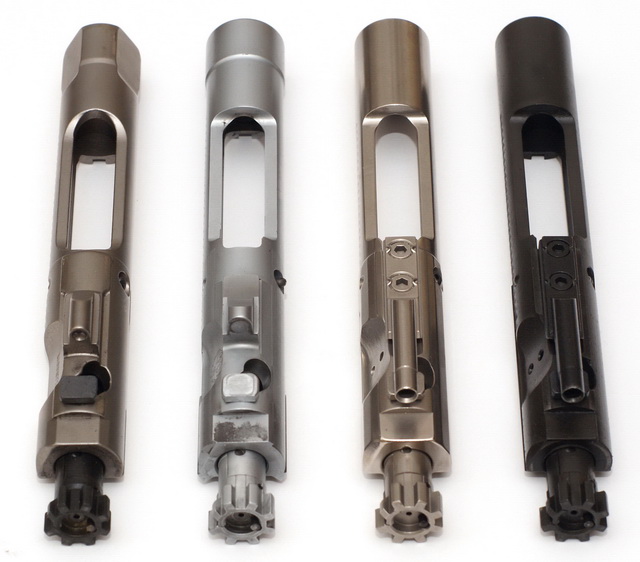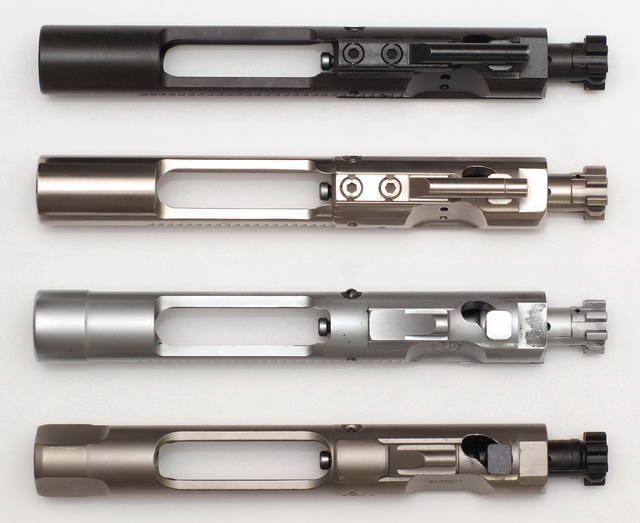Most firearm action components are made of steel, but they can be given a variety of coatings with remarkable properties. Shown here are four AR-15 bolt-carrier groups (BCGs). From top to bottom they are coated in:
- Phosphate, a.k.a., parkerized
- Nickel-boron, a.k.a. NiB
- Chrome
- Nickel-Teflon, a.k.a. NP3
Phosphate
Phosphated steel has been used in guns for over a century, and is still the military standard for BCGs. The one shown here is from a premium Noveske rifle. I asked Noveske why they don’t use a more modern coating and was told, “Even though the smooth hard coatings take a few seconds less to clean they do not hold oil. Oil keeps the gun running longer and keeps the gun from wearing out. The standard parkerizing holds on to oil longer than any other finish. It keeps the gun running longer.” Indeed, the finish on this BCG is rough and soaks up lubricant like a sponge, though it also seems like a magnet for grit and fouling.
Chrome
Chrome is widely used in barrels and chambers because it is extremely hard, corrosion resistant, and smooth. I’ve run the one shown here from a Ruger SR-556 more than any other single AR-15. It is easier to clean and requires less lubricant than a standard BCG. I suspect it should also be less prone to failures if insufficiently lubricated.
Nickel-Teflon
NP3 is a relatively soft coating of Teflon-impregnated nickel done by ROBAR. Due to its softness it will show wear, but due to its lubricity I am not aware of any instances of it wearing through. It is so slippery that any fouling can be wiped off with a dry rag. The BCG here is from a Barrett Rec7. Wilson Custom also uses NP3 on all their BCGs.
Nickel-boron
The industry leader in NiB coatings for firearms is WMD Guns, which markets the coating as NiB-X, and which spun off from FAILZERO, which markets it as EXO. Shown here is a new $200 mil-spec NiB-X BCG.
Both NP3 and NiB are lubricious enough to run without lubricants. (In fact, like dirt, lubricants can’t really adhere to these electroless nickel-based coatings.) ROBAR claims that NP3 is more consistently lubricious than NiB and significantly more corrosion resistant. NiB is hard enough that you can use steel scrapers and brushes to clean it. However it is not as smooth as NP3 or chrome, so you need a lot more than a cloth to remove the discoloration of carbon fouling that embeds itself in NiB’s microscopic surface irregularities. Granted, that’s a cosmetic issue, not a functional one. It does, however, lend plausibility to a few reports of NiB BCGs jamming up and needing lubricant to unlock.

For somebody like me who likes to clean my guns to like-new condition it is dismaying to find that NiB parts get discolored by microscopic fouling that is nearly impossible to remove. On the basis of that, and the fact that Barrett and Wilson use it, I will probably steer towards NP3 for coating any action parts in the future, with one caveat: I had the bolt on my DTA NP3-coated and it resulted in a noticeably stiffer cycle, presumably because of the added thickness of the coating. I expect it to eventually break in, but I’ll also avoid after-market coating any parts that are machined to extremely tight tolerances.

Hello from ROBAR.
We enjoyed your article, you have a lot of great information in there. It was very well written and we agree with much of what you say. (you really know your coatings!). We would like to thank you for using and recommending our NP3 coating.
If you don’t mind we did want to clarify a few points.
On NP3 being “soft” we would like to specify. NP3 has a rockwell hardness that can go from around 42-48 depending on what it is plated on. The steel like a mil-spec bolt for the AR rifle is made out of 9310 steel and has a rockwell hardness of 40. A mil-spec extractor is going to be in the rockwell hardness of the low 30’s. This is just to explain that NP3 is still very hard and will last longer than the other parts in your rifle. In fact when using one type of steel that is much harder than a softer metal it makes contact with, the softer metal may wear much faster.
Finally, the thickness of NP3 is around .0003 This makes it suitable for every type of firearm even with tight tolerances (we just did a Les Baer 1911 in NP3, they are really into tight guns at Les Baer). If for some reason the action on your Desert Tactical Arms is impeded by the thickness of NP3 let us know that is not something that we will let stand and we pride ourselves on customer service to meet or exceed our customers needs.
Again great article and thank you for your business.
Pingback: EmptorMaven » Blog Archive » The Problem With Nickel-Boron
Pingback: ARP 067 - Coatings Extravaganza | AR-15 PodcastAR-15 Podcast
Can’t wait to evaluate these TiN, CrN, and DLC coatings.